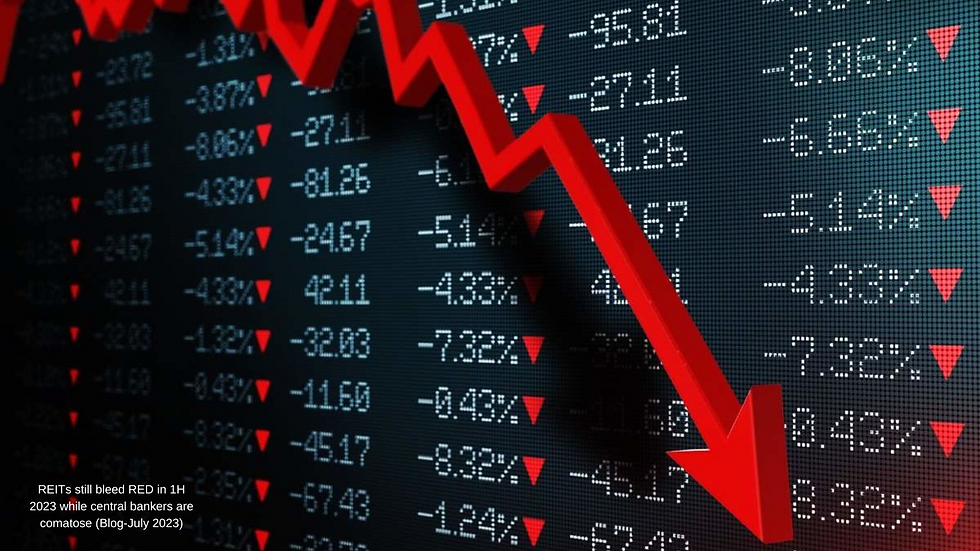THE BEAUTIFUL CORRECTION BY GABRIEL YAP
- by Gabriel Yap

- Nov 18, 2017
- 3 min read
07/2013-
A stockmarket correction is a beautiful thing as it adjust equity prices closer to their actual or intrinsic values. In reality, it is much easier than that – stock prices come down because of speculator reactions to expectations of news, reactions to actual news and profit taking.

The former “becauses” are more potent than ever before as there is more “self directed” money out there in the market due to extensive Quantitative Easing, QE measures by central banks across the world. Therein lies the core of correctional beauty!
I had warned of this current market correction in my various media programs over TV and Radio in late-April. One of my premise was that the market has gone up 6 consecutive months without an iota of more than 3% correction since the last correction which lasted 3 months from 14th Aug 2012 till 16th Nov 2012. Henceforth, the FTSTI has climbed a whopping 755 points or 28% in just 6 months up till 22nd May 2013, the eve of Vesak Day.
An analysis of FTSTI past 5 market corrections since the bottom was hit at 1,345 on 9th Mar 2009, is quite interesting –

In terms of duration, the shortest correction lasted 30 days while the longest was the last one which lasted almost 3 months. The average correction was 50 days or about 1.5 months.
In terms of gravity, the sharpest was the 1st Aug 2011 till 5th Oct 2011 selloff where the FTSTI plunged 705 points or 21.9%. The other 4 corrections were almost similar in magnitude – they were down by an amazing similar 11 -12%.
In terms or regularity, a correction almost certainly rears its C-head 5 – 7 months after the last correction. The longest C-to-C was 7 months while the shortest was 2 months.
In my more than 20 years of investing (I started watching the stock market and was chasing stocks while in college while my class mates were chasing girls) experience, I actually revel in market corrections as there has never been a correction that has not proven to be a good buying opportunity.
Nonetheless, most investors actually go into a despondent mode as prices tumble and good buying opportunities surface as they had either bought at the peak or bought into the wrong stocks. As in Shakespeare, “Time and Tide waits for no man (or woman)”, thus, a good understanding of market timing and taking actions to lighten portfolios just before market corrections are key to success in investing.
For sure, some investors psychological make-up is disorientated during a market correction as they blame themselves for buying in too soon and selling out not so soon. But really, the stock market is no place for hindsight – one should move forward and try to “perfect” one’s reading of the markets.
If you had the foresight to lighten up before the correction, you may also resist from buying too quickly. I normally hope for a short and steep decline, but would prepare for a long one as there investors’ get more unsure and become more nervous as markets drag and rough it out.
Market corrections also allow my strategy of building my portfolios around High Yield Securities (see my March topic on “Profiting from High Yield Stocks”) to shine through. It is an opportune time for me to utilise my steady cashflows (REITS pay out their dividends every quarter while other high yield stocks pay out every 6 months) to buy in at cheaper values.
If you have saved for the rainy day – corrections are one of the best times to deploy these rainy day reserves. Yes, market values of stocks may go down after you buy them, but to me, they are merely a perceptual issue while waiting for the market turning point.

The other interesting facet about a normal market correction is – what goes up the fastest and sharpest, will fall the most as for eg using the REITS to illustrate:-
As predicted again, when the REITS corrected the most, most reasons ranging from an increase in interest rates impacting their DPU to a possible increase in capitalization rates (which will then adjust asset prices downwards) are put forward to explain the fall in prices.
But why did these prognosticators warn us before the correction rather than hearing them explaining the correction?

Again, most of the REITS that fell the sharpest has recovered the fastest. Actually does one really need to be so smart to grasp all regression analysis and their impact on stock prices or just to know enough to prepare and take advantage of the “beautiful correction” to make money in life?
You tell me.




Comments